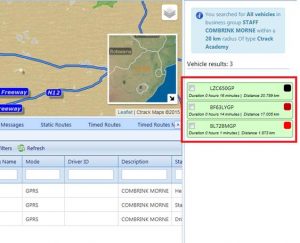 IVMS/ GPS Tracking changes driver behaviour in the longer term: as soon as drivers know there are IVMS/ GPS Tracking systems in their vehicles, they slow down and they drive more gently. Nobody likes to be reported as a law breaker or as somebody that damages their employer’s vehicle – this makes IVMS/ GPS Tracking one of the most effective tools to not only save lives, but also save costs. As we have maintained through the years: IVMS/ GPS Tracking pays for itself through damage and vehicle abuse reductions, driver safety comes as a free and very vital add-on.
IVMS/ GPS Tracking changes driver behaviour in the longer term: as soon as drivers know there are IVMS/ GPS Tracking systems in their vehicles, they slow down and they drive more gently. Nobody likes to be reported as a law breaker or as somebody that damages their employer’s vehicle – this makes IVMS/ GPS Tracking one of the most effective tools to not only save lives, but also save costs. As we have maintained through the years: IVMS/ GPS Tracking pays for itself through damage and vehicle abuse reductions, driver safety comes as a free and very vital add-on.
A problem with any IVMS/ GPS Tracking system is that it has many single points of failure: a single unit off a single power source (open to tampering), data coming through a single Telco link to a single point and processed on a single server. Of course Digicore takes whatever steps it can to ensure that our IVMS/ GPS Tracking systems are served by as much redundancy as we can provide, but the reality is that we cannot double up on every single link between a vehicle’s dashboard and a customer’s online display – this is not only virtually impossible but would also be cost prohibitive.
So how can IVMS/ GPS Tracking be made an even safer system when it comes to driver protection?: There are a number of ways. Fitting a high-gain antenna or a satellite radio would make IVMS/ GPS Tracking safer in terms of network coverage, having additional data links into an IVMS/ GPS Tracking supplier’s site helps in the event of a high-speed link failure, but these all still have to do with getting data into a server.
A philosophical shift in IVMS/ GPS Tracking is required where it becomes about driver safety in the first place, and this is where journey management becomes vital. How does this work?: Users would sign onto their IVMS/ GPS Tracking system’s online interface and set arrival times for vehicles. So, if an employee needs to arrive at a certain time at a certain place, this is entered online. As the vehicle moves its IVMS/ GPS Tracking system reports it position and the IVMS/ GPS Tracking backend system tracks progress. A vehicle could roll or a driver could have a heart attack, in which case all communication with the vehicle could be lost. With journey management the IVMS/ GPS Tracking system is watching matters from a different angle: rather than rely on GPS data pouring into the base system, the lack of data is flagged as an issue.
Here is an example:
Darren left the office at 08:00 am and should be at point one by 12 pm and at point two by 3pm. He arrives at point one in time, but then something happens and he does not arrive at point two in time. Up to point one the IVMS base system is happy and does nothing, but when no position data is received from point two by the set time, the base system escalates to a monitoring station or it sends an SMS to a set number. This is where a human being gets involved – hopefully the problem lies with some small technical issue somewhere and it can be closed off, but if not then the IVMS/ GPS Tracking online interface is used to see when last contact was had from the vehicle and emergency services can be dispatched if necessary.
IVMS/ GPS Tracking – a system that truly pays for itself every step of the way!
 “In the civil & mining sector, efficiency and safety are our top priorities. Digicore has been a cornerstone of our operations, providing us with cutting-edge IVMS solutions. What impresses us the most is their ability to comprehend our unique challenges and design solutions that are both effective and cost-efficient. Their after-sales support is exceptional - always reachable, always proactive. It's a pleasure to partner with such a trustworthy, 100% Australian owned company.”
“In the civil & mining sector, efficiency and safety are our top priorities. Digicore has been a cornerstone of our operations, providing us with cutting-edge IVMS solutions. What impresses us the most is their ability to comprehend our unique challenges and design solutions that are both effective and cost-efficient. Their after-sales support is exceptional - always reachable, always proactive. It's a pleasure to partner with such a trustworthy, 100% Australian owned company.”
 “We have worked with Digicore for over the last 10 years and at every stage they have come up with innovative and price effective ways in which to help our business. As we grew, our demands grew and Dan from Digicore continued to provide excellent service and the best products.”
“We have worked with Digicore for over the last 10 years and at every stage they have come up with innovative and price effective ways in which to help our business. As we grew, our demands grew and Dan from Digicore continued to provide excellent service and the best products.”
 “I want to say thank you for the phenomenal service and input Digicore has had, it has been particularly helpful in providing input to our business IVMS plans. Your team were incredibly professional and Digicore IVMS 2.0 is a very impressive solution.”
“I want to say thank you for the phenomenal service and input Digicore has had, it has been particularly helpful in providing input to our business IVMS plans. Your team were incredibly professional and Digicore IVMS 2.0 is a very impressive solution.”
 “We started with a large tracking company and got locked in before discovering their units didn't have the functions we required. We switched to Digicore and we couldn't be happier. The product is excellent, pricing is very competitive but more importantly their product knowledge and support is second to none.”
“We started with a large tracking company and got locked in before discovering their units didn't have the functions we required. We switched to Digicore and we couldn't be happier. The product is excellent, pricing is very competitive but more importantly their product knowledge and support is second to none.”